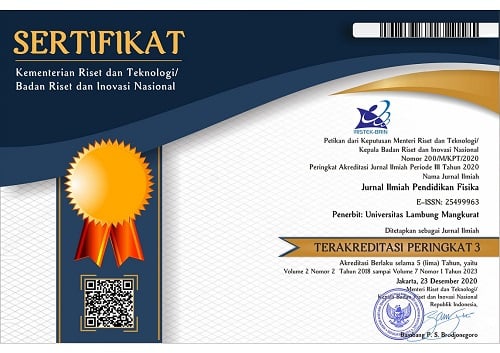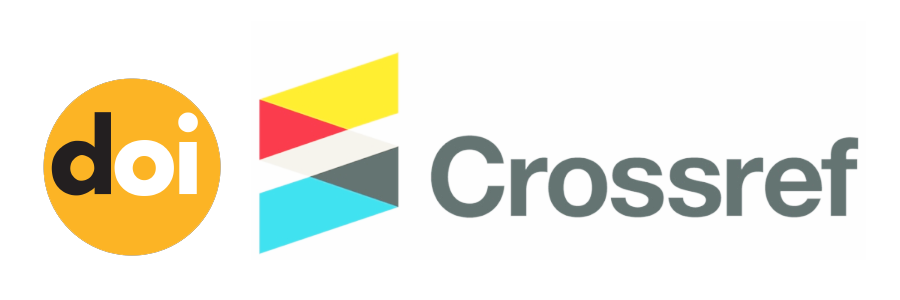The Profile of Scientific Literacy and Self-Concept in Learning Physics
Abstract
Based on the findings of interviews and preliminary observations, there are various issues with learning physics, including the continued use of the expository approach and a reliance on the capacity to recall topics without comprehending their significance. This study aimed to characterize the profile of students' scientific literacy and self-concept. The descriptive research approach was employed in this study, with a single case design. Learning observation sheets, interview sheets, scientific literacy tests, and student self-concept surveys were utilized as study instruments. The quantitative data acquired from questionnaires and tests in this study will be examined descriptively by percentage. Students' scientific literacy abilities are still rather low in general. Competency domain indicators for explaining scientific phenomena are in the medium category, obtaining a percentage of 78%, while competency domain indicators for evaluating and designing scientific investigations are in a low category, obtaining a percentage of 58%, and competency domain indicators for interpreting data and scientific evidence are in the deficient category, obtaining a percentage of only 46%. Students' attitudes toward learning physics are rated as modest. Based on the outcomes of this study, more in-depth research utilizing appropriate learning models is required to monitor success in physics learning and develop students' scientific literacy abilities.
Keywords
Full Text:
PDFReferences
Arikunto, S. (2010). Prosedur penelitian suatu pendekatan praktik. Jakarta: PT. Rineka Cipta.
Arisman, A. (2015). Penerapan pembelajaran kooperatif tipe stad dengan metode praktikum dalam pembelajaran ipa terpadu untuk meningkatkan literasi sains siswa. Prosiding Seminar Nasional Fisika (E-Journal), 4, SNF2015-I. http://journal.unj.ac.id/unj/index.php/prosidingsnf/article/view/4667
Astalini, A., Darmaji, D., Kurniawan, D., Anggraini, L., & Perdana, R. (2021). E-Assessment on student’s self-concept for physics learning. Jurnal Ilmu Pendidikan, 25(2), 73-81. http://dx.doi.org/10.17977/um048v25i2p73-81
Chao, C. N. G., McInerney, D. M., & Bai, B. (2019). Self-efficacy and self-concept as predictors of language learning achievements in an Asian bilingual context. The Asia-Pacific Education Researcher. 28(2), 139-147. https://doi.org/10.1007/s40299-018-0420-3
Chen, B. H., Chiu, W-C., & Wang, C-C. (2015). The relationship among academic self-concept, learning strategies, and academic achievement: A case study of national vocational college students in Taiwan via SEM. The Asia-Pacific Education Researcher, 24(2), 419–431. https://doi.org/10.1007/s40299-014-0194-1
Erten, ̇I. H., & Burden, R. L. (2014). The relationship between academic self-concept, attributions, and L2 achievement. System, 42, 391–401. https://doi.org/10.1016/j.system.2014.01.006
Hall, C. S., &Lindzey, G. (1978). Theories of personality. third edition. New York: John Willey and Sons, Inc.
Huryah, F., Sumarmin, R., & Effendi, J. (2017). Analisis capaian literasi sains biologi siswa SMA kelas X se Kota Padang. Jurnal Eksakta Pendidikan (JEP), 1(2), 72-79. https://doi.org/10.24036/jep.v1i2.70
Irwan, A. P. (2020). Analisis kemampuan literasi sains pesrta didik ditinjau dari kemampuan menyelesaikan soal fisika di SMAN 2 Bulukumba. Jurnal Sains Dan Pendidikan Fisika, 15(3), 17–24. https://doi.org/10.35580/jspf.v15i3.13494
Marsh, H. W., & Craven, R. G. (2006). Reciprocal effects of self-concept and performance from a multidimensional perspective: Beyond seductive pleasure and unidimensional perspectives. Perspectives on Psychological Science, 1(2), 133–163. https://doi.org/10.1111/j.1745-6916.2006.00010.x
Marsh, H. W., Parker, J., & Barnes, J. (1985). Multidimensional adolescent self-concepts: Their relationship to age, sex and academic measures. American Educational Research Journal, 22(3), 422–444. https://doi.org/10.2307/1162973
McMillan, J. H., & Schumacher, S. (2001). Research in education. New York: Longman, Inc.
Merta, I. W., Artayasa, I. P., Kusmiyati, K., Lestari, N., & Setiadi, D. (2020). Profil literasi sains dan model pembelajaran dapat meningkatkan kemampuan literasi sains. Jurnal Pijar MIPA, 15(3), 223. https://doi.org/10.29303/jpm.v15i3.1889.
Mukharomah, F., Wiyanto, W., & Putra, N. M. D. (2021). Analisis kemampuan literasi sains fisika siswa SMA pada materi kinematika gerak lurus. JoTaLP: Journal of Teaching and Learning Physics, 6(1), 11-21. https://doi.org/10.15575/jotalp.v6i1.10391
Ning, D. R., Roshayanti, F., & Siswanto, J. (2020). Profil literasi sains dan berfikir kreatif siswa SMP Negeri 11 Pekalongan. JEMS: Jurnal Edukasi Matematika dan Sains, 8(2), 150-156. https://doi.org/10.25273/jems.v8i2.6905.
OECD. (2013). PISA 2012 results: Creative problem solving: Students’ skills in tackling real-life problems (Volume V), Paris: OECD Publishing.
OECD. (2015a). Enabling the next production revolution. Paris: OECD Publishing.
OECD. (2015b). PISA result in focus. Paris: OECD Publishing.
OECD. (2018). Programme for International Student Assessment (PISA) Result from PISA 2018. Programme for International Student Assessment (PISA) Result from PISA 2018, 1–10.
http://www.oecd.org/pisa/Data
Palloan, P., Usman, U., & Hakim, A. (2021). The influence between self-concept and emotional intelligence on the ability of physics problem solving. Jurnal Pendidikan Fisika Indonesia, 17(1), 31-39. https://doi.org/10.15294/jpfi.v17i1.26111
Pertiwi, U. D., Atanti, R. D., & Ismawati, R. (2018). Pentingnya literasi sains pada pembelajaran IPA SMP abad 21. Indonesian Journal of Natural Science Education (IJNSE), 1(1), 24–29. https://doi.org/10.31002/nse.v1i1.173
Rahmanyar, S., Faizi, A., & Shahryar, S. A. (2022). Investigating the factors of students lack of interest in physics at Kunduz University. Technium Education and Humanities, 2(2). 22-32.
Riduan. (2004). Belajar mudah penelitian untuk guru-karyawan dan peneliti pemula. Medan: Alfabeta.
Rusilowati, A., Kurniawati, L., Nugroho, S. E., & Widiyatmoko, A. (2016). Developing an instrument of scientific literacy asessment on the cycle theme. International Journal of Environmental and Science Education, 11(12), 5718–5727.
Saraswati, Y., Indana, S., & Sudibyo, E. (2021). Science literacy profile of junior high school students based on knowledge, competence, cognitive, and context aspects. IJORER: International Journal of Recent Educational Research, 2(3), 329-341.
https://doi.org/10.46245/ijorer.v2i3.118
Saß, S., & Kampa, N. (2019). Self-concept profiles in lower secondary level – An explanation for gender differences in science course selection? Frontiers in Psychology, 10, 836. https://doi.org/10.3389/fpsyg.2019.00836
Setiawani, E., Apsari, N., & Lestrai, N. (2021). Assesment literasi sains dimensi kompetensi pada materi pemanasan global. Jurnal Pembelajaran IPA dan Aplikasi (QUANTUM), 1(1), 1-8.
Shavelson, R. J., Hubner, J. J., & Stanton, G. C. (1976). Self-concept: Validation of construct interpretations. Review of Educational Research, 46, 407–441. https://doi.org/10.3102/00346543046003407
Sutrisna, N. (2021). Analisis kemampuan literasi sains peserta didik SMA di Kota Sungai Penuh. Jurnal Inovasi Penelitian, 1(12), 2683-2694. https://doi.org/10.47492/jip.v1i12.530
Syah, N., & Busra, N. (2018). Penerapan pembelajaran konstruktivisme untuk meningkatkan konsep diri dan hasil belajar siswa. Jurnal Pendidikan Teknologi Kejuruan, 1(1), 8-12. https://doi.org/10.24036/jptk.v3i1.523
Utama, M. N., Ramadhani, R., Rohmani, S. N., & Prayitno, B. A. (2019). Profil keterampilan literasi sains siswa di salah satu sekolah menengah atas (SMA) negeri di Surakarta. Didaktika Biologi: Jurnal Penelitian Pendidikan Biologi, 3(2), 57–67.
https://doi.org/10.32502/dikbio.v3i2.1296
DOI: https://doi.org/10.20527/jipf.v7i1.7025
Refbacks
- There are currently no refbacks.
Indexed by: Jurnal Ilmiah Pendidikan Fisika is licensed under a creative commons attribution-share alike 4.0 international license
Statistics Counter |
















